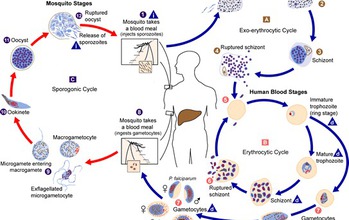Multimedia Gallery
The Centers for Disease Control and Prevention has mapped out malaria's two-host life cycle.
The malaria parasite life cycle involves two hosts, illustrated in this chart from the Centers for Disease Control and Prevention. During a blood meal, a malaria-infected female Anopheles mosquito inoculates sporozoites into the human host. Those sporozoites infect liver cells. From there, the parasite matures, multiplies and invades the bloodstream (some strains can persist in the liver and cause relapses by invading the bloodstream weeks, or even years later). When another female Anopheles mosquito bites the infected human, it ingests malaria gametocyctes, beginning the mosquito stages of the parasite's life. Li's virus would make an infected human a "dead end" for the disease, so that any mosquitoes that bite that person would not be able to spread it.
Credit: CDC
Images credited to the National Science Foundation, a federal agency, are in the public domain. The images were created by employees of the United States Government as part of their official duties or prepared by contractors as "works for hire" for NSF. You may freely use NSF-credited images and, at your discretion, credit NSF with a "Courtesy: National Science Foundation" notation.
Additional information about general usage can be found in Conditions.
Also Available:
Download the high-resolution GIF version of the image. (43.5 KB)
Use your mouse to right-click (Mac users may need to Ctrl-click) the link above and choose the option that will save the file or target to your computer.
Related story: Breaking the cycle of malaria transmission



